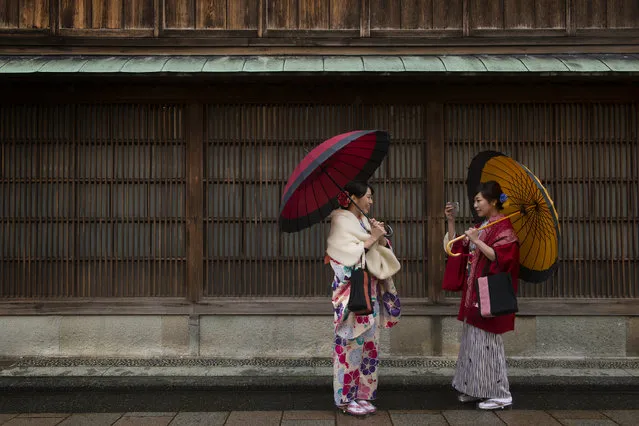
Young women celebrating the coming of age wear traditional japanese attire while visiting the Higashi-Chaya-gai is a historic geisha tea house district in Kanazawa, Japan on January 8, 2016. Some have been converted into homes, others into shops that sell trinkets or sweets. (Photo by Linda Davidson/The Washington Post)
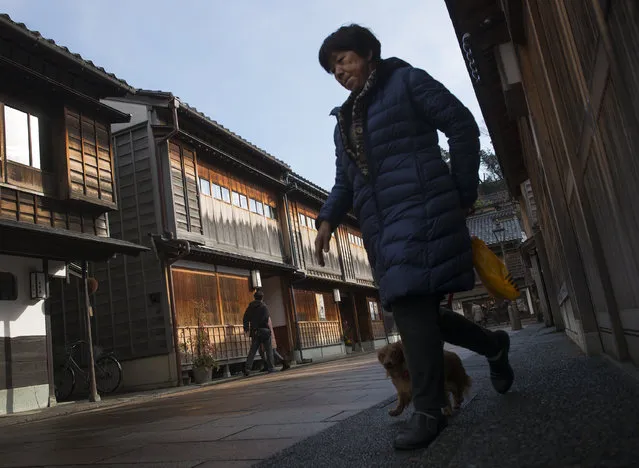
Higashi-Chaya-gai is a historic geisha tea house district in Kanazawa, Japan on January 8, 2016. (Photo by Linda Davidson/The Washington Post)
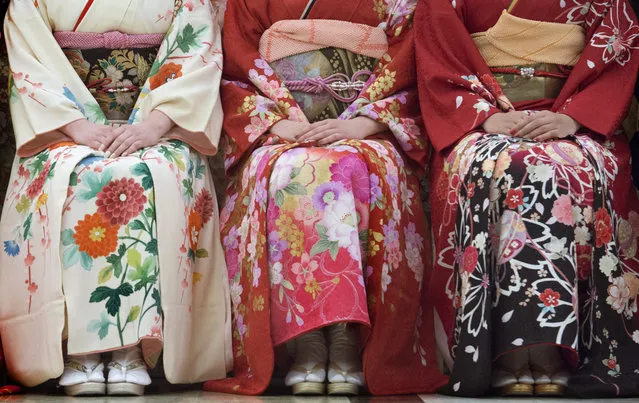
View of young women in kimonos at the Seijin no Hi (Coming-of-Age) ceremony in Kanazawa, Japan on January 10, 2016. Japanese men and women who have reached the legal age of 20 over the past year were honored as shin-seijin or “new adult” during the national holiday. For most young people, the ceremony is an opportunity to dress in their most formal clothes that emphasize the old Japanese traditions. Women dressed in fine silk kimonos complete with fancy hair styles, nails, fur collars, makeup and accessories. Men occasionally wear a hakamas, a wide-pleated garment tied at the waist and worn to the ankles. But most wear a western style dark suit to Seijin no Hi. In Japan, when one reaches age 20, they are legally entitled to vote, drink and manage their own affairs. Local government officials usually do the honors by giving speeches at the ceremony. In Kanazawa, an after party with food, games and door prizes was held for a crowd of about 150 youth. According to recent reports, there has been a steady decline in young people's attitudes toward attending Seijin no Hi. That as well as a declining birth rate in Japan may be to blame. (Photo by Linda Davidson/The Washington Post)

Young japanese women and men take “selfies” during the Seijin no Hi (Coming-of-Age) ceremony in Kanazawa, Japan on January 10, 2016. (Photo by Linda Davidson/The Washington Post)
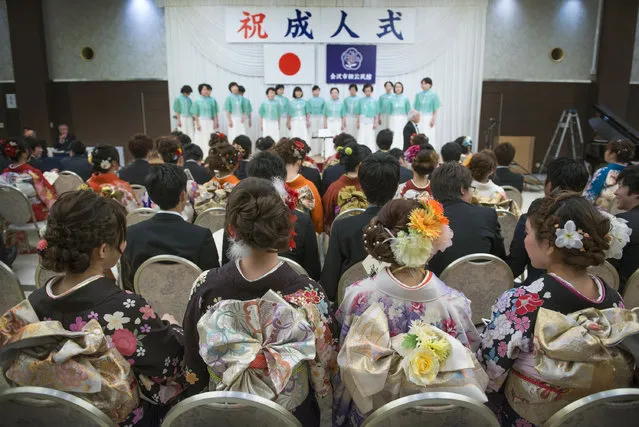
View of the “obi” kimono sashes on young women at the Seijin no Hi (Coming-of-Age) ceremony in Kanazawa, Japan on January 10, 2016. (Photo by Linda Davidson/The Washington Post)
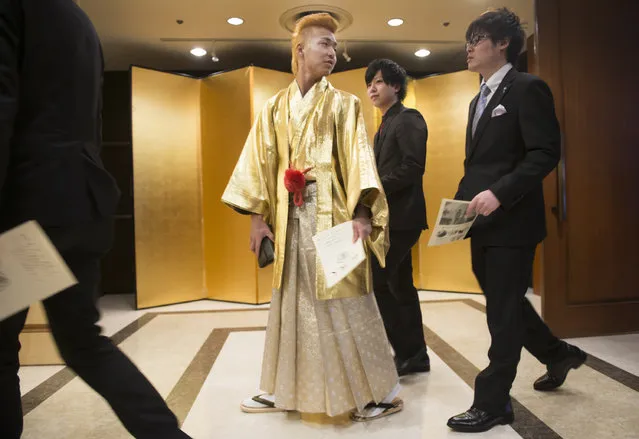
A young man with a gold mohawk in a hakama among others in business suits arrives at the Seijin no Hi (Coming-of-Age) ceremony in Kanazawa, Japan on January 10, 2016. (Photo by Linda Davidson/The Washington Post)
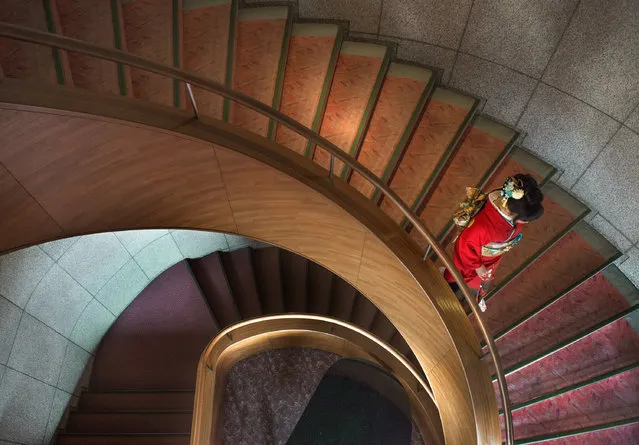
A young woman in a traditional kimono exits the grand staircase after the Seijin no Hi (Coming-of-Age) ceremony in Kanazawa, Japan on January 10, 2016. (Photo by Linda Davidson/The Washington Post)
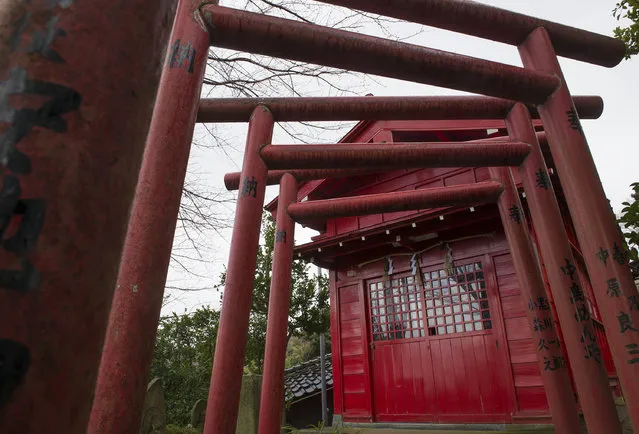
View of gate house to Hosenji Temple in the Utatsuyama Temple district in Kanazawa, Japan on January 8, 2016. This hilly district boasts numerous Buddhist temples and Shinto shrines and a great view of the city. (Photo by Linda Davidson/The Washington Post)

Grave markers behind the Hosenji temple in the Utatsuyama Temple district in Kanazawa, Japan on January 8, 2016. (Photo by Linda Davidson/The Washington Post)

View of the Kanazawa Castle in Kanazawa, Japan on January 8, 2016. Though the largest and most distinguished building in Old Kanazawa the building is relatively new in its construction. It was originally built in 1580 but previous warlord battles, fires and even an earthquake destroyed several times. (Photo by Linda Davidson/The Washington Post)
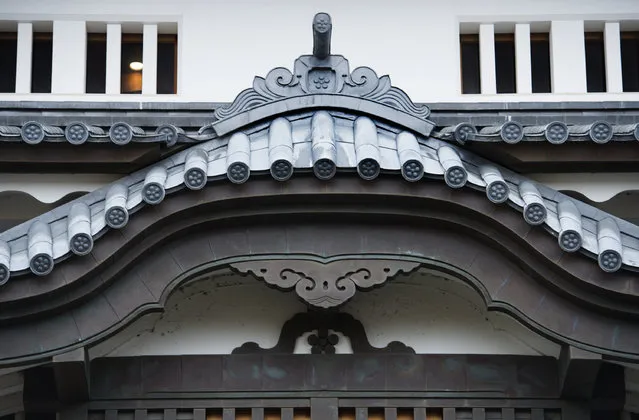
View of reconstructed details on the Kanazawa Castle in Kanazawa, Japan on January 12, 2016. The castle's history dates back to the 16th century but several fires and wars later, the castle and other fortress buildings were burned to the ground and rebuilt. (Photo by Linda Davidson/The Washington Post)
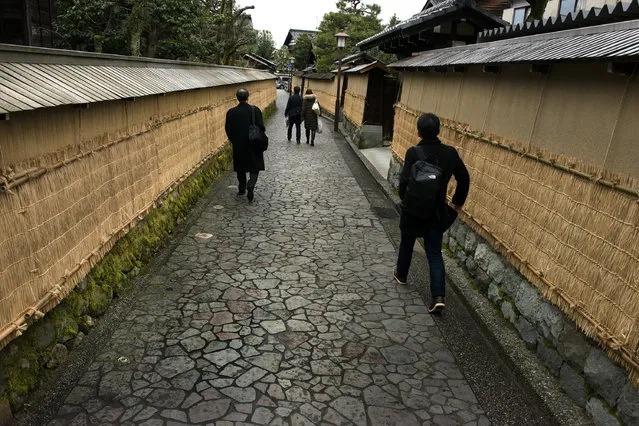
View of the restored mud walls (with protective straw mats on them for protection) in the Naga-machi Buke Yashiki District in Kanazawa, Japan on January 12, 2016. Kanazawa was a castle town of the Kaga Clan governed by the Maeda family until 1868 (about 280 years) after Maeda Toshiie moved to Kanazawa Castle in 1583. The residences of two of the eight chief retainers of the Kaga Clan were located in the Naga-machi area, where top- and middle-class samurais lived. (Photo by Linda Davidson/The Washington Post)
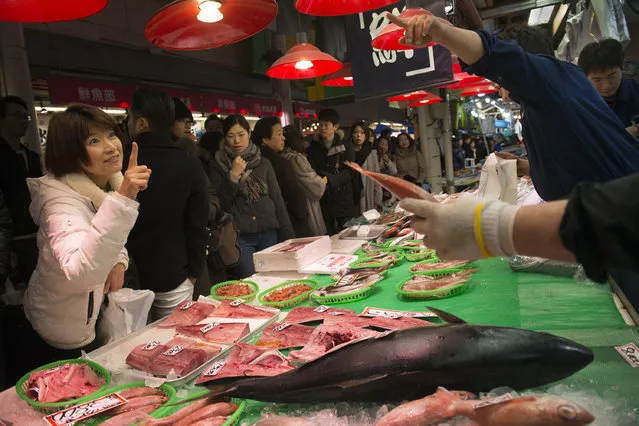
Fresh seafood and produce are found at the Omi-Cho market in Kanazawa, Japan on January 8, 2016. Kanazawa is known for sushi and patrons to Omicho can have it served to them while they shop. Shoppers can pick out seafood and in some shops, have it grilled for them to consume on the spot. (Photo by Linda Davidson/The Washington Post)
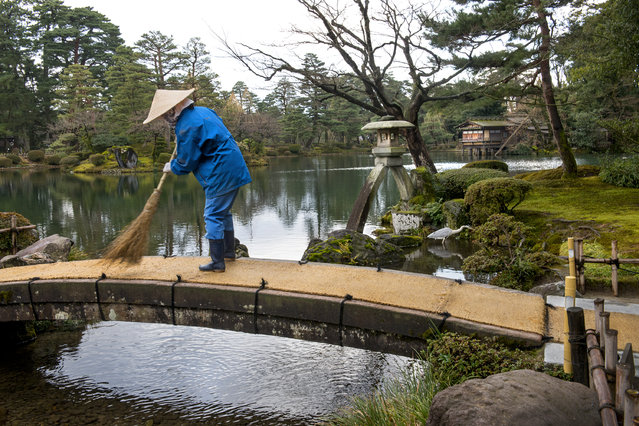
A groundskeeper uses a bamboo broom at Kasumigaike Pond at Kenrokuen Garden in Kanazawa, Japan on January 12, 2016. The japanese garden, located next to Kanazawa Castle, encompasses over 28 acres in downtown Kanazawa. With two ponds, rolling hills with streams and bridges, is considered a strolling-style landscape garden. It's regarded as one of the top three most beautiful gardens in Japan. (Photo by Linda Davidson/The Washington Post)
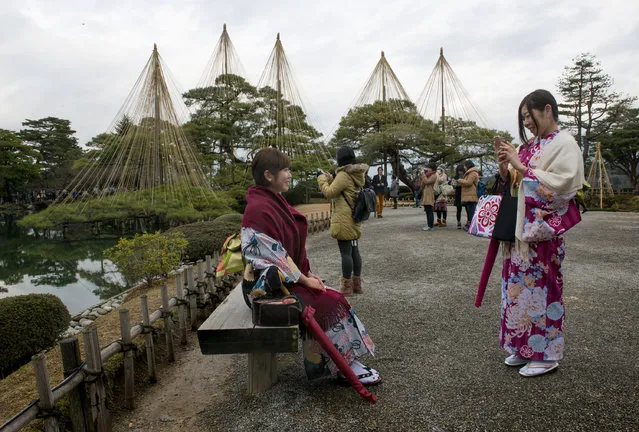
Young women clad in Kimonos take photos in front of the Karasakinomatsu Pine trees in Kenrokuen Garden in Kanazawa, Japan on January 8, 2016. Because Kanazawa gets heavy snow in the winter, branches are supported by a teepee-shaped bamboo and rope structure to protect them from breaking. (Photo by Linda Davidson/The Washington Post)
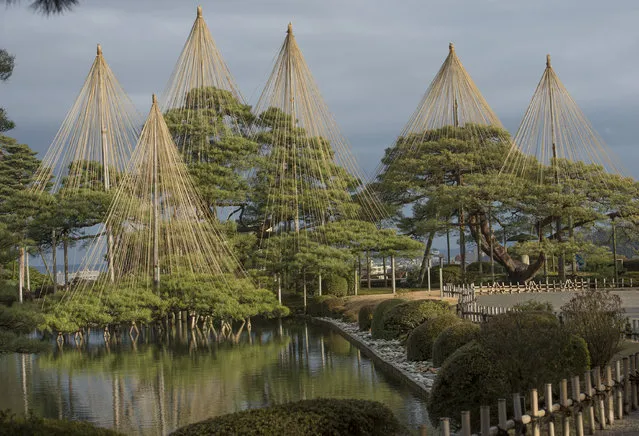
Karasakinomatsu Pine trees with an array of rope supports at Kenrokuen Garden in Kanazawa, Japan on January 12, 2016. In winter, to protect the trees from heavy snow, workers attach ropes to frail branches and support the tree with a bamboo pole. The garden, located next to Kanazawa Castle, encompasses over 28 acres in downtown Kanazawa. With two ponds, rolling hills with streams and bridges, is considered a strolling-style landscape garden. It's regarded as one of the top three most beautiful gardens in Japan. (Photo by Linda Davidson/The Washington Post)

Koi in Hisagoike Pond in Kenrokuen Garden in Kanazawa, Japan on January 12, 2016. The japanese garden, located next to Kanazawa Castle, encompasses over 28 acres in downtown Kanazawa. With two ponds, rolling hills with streams and bridges, is considered a strolling-style landscape garden. It's history dates back to the Edo period (1603-1868). It's regarded as one of the top three most beautiful gardens in Japan. (Photo by Linda Davidson/The Washington Post)
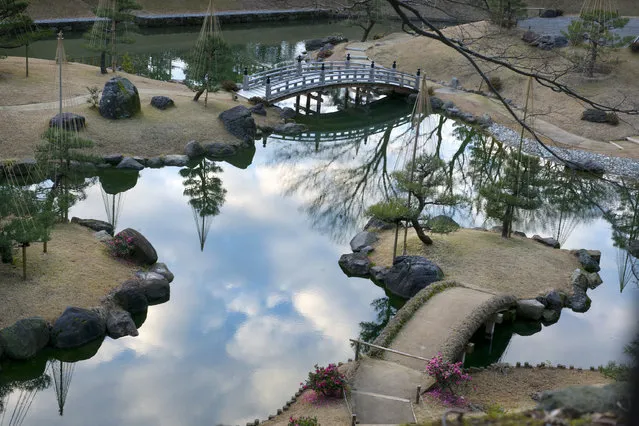
View of Gyokusen-inmaru Garden in Kanazawa, Japan on January 8, 2016. Gyokusen-inmaru Garden existed in Kanazawa Castle's Gyokusen-inmaru from 1634, when Toshitsune Maeda, the third lord of the Kaga Domain, had it constructed, until the abolition of the feudal system. The garden was abandoned in the Meiji Era (1868-1912) and lost its former appearance. However, reconstruction work was initiated in May of 2013, following a design process based on the results of a five-year excavation survey that began in 2008, as well as old drawings, literature, similar case studies, and other information. (Photo by Linda Davidson/The Washington Post)
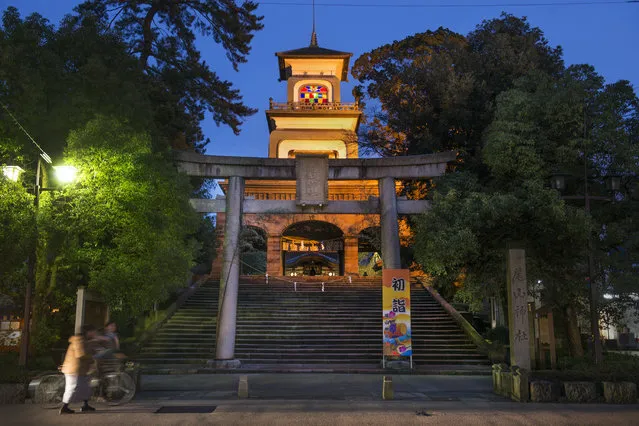
Amidst the hustle and bustle of city life, the main gate to the Oyama Jinja shrine stands tall in Kanazawa, Japan on January 12, 2016. The shrine (not pictured) was established in 1599 in Utatsuyama and moved to its present location in 1873 and renamed to Oyama-jinja. The main gate was constructed in 1875. This gate is a peculiar mix of traditional Japanese, Chinese, and European religious architectural elements. The gate is 25 metres (82 ft) high including the lightning rod. (Photo by Linda Davidson/The Washington Post)
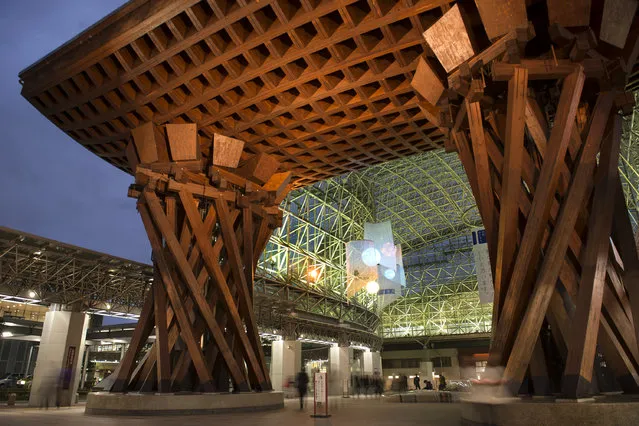
View of Outside the Kanazawa Station concourse is the red-colored Tsuzumi Gate in Kanazawa, Japan on January 8, 2016. The design of the gate is based on traditional Japanese hand drums or tsuzumi. (Photo by Linda Davidson/The Washington Post)
03 Feb 2016 13:36:00,
post received
0 comments
